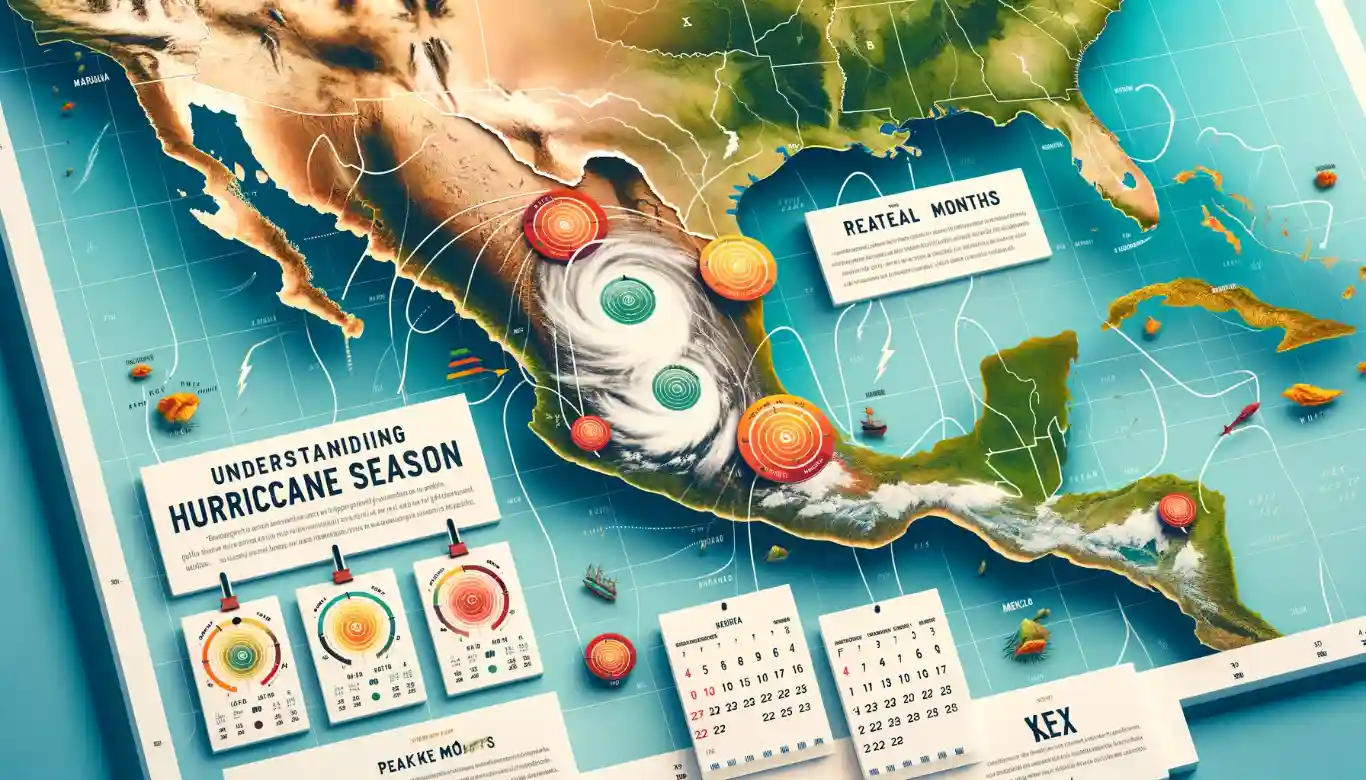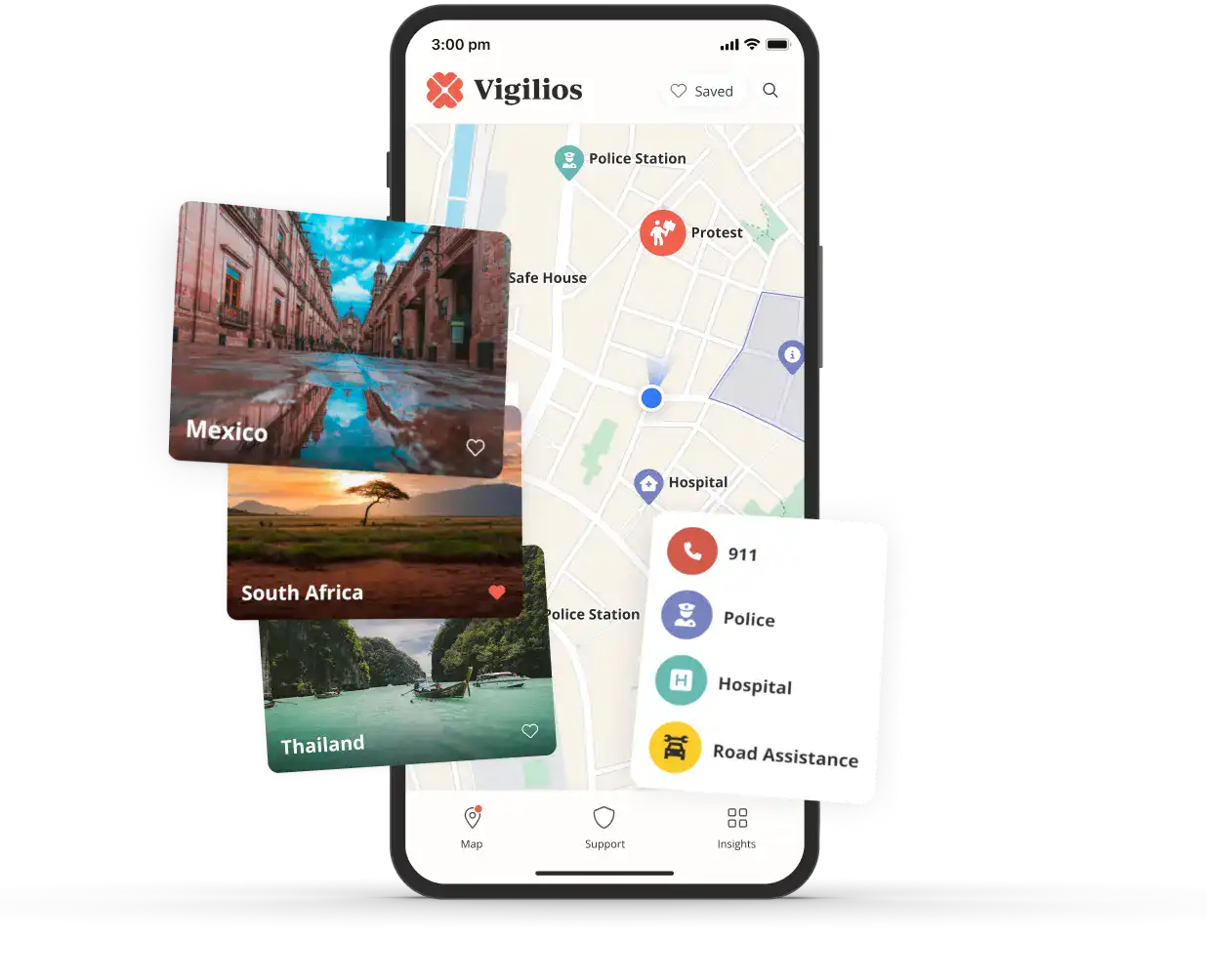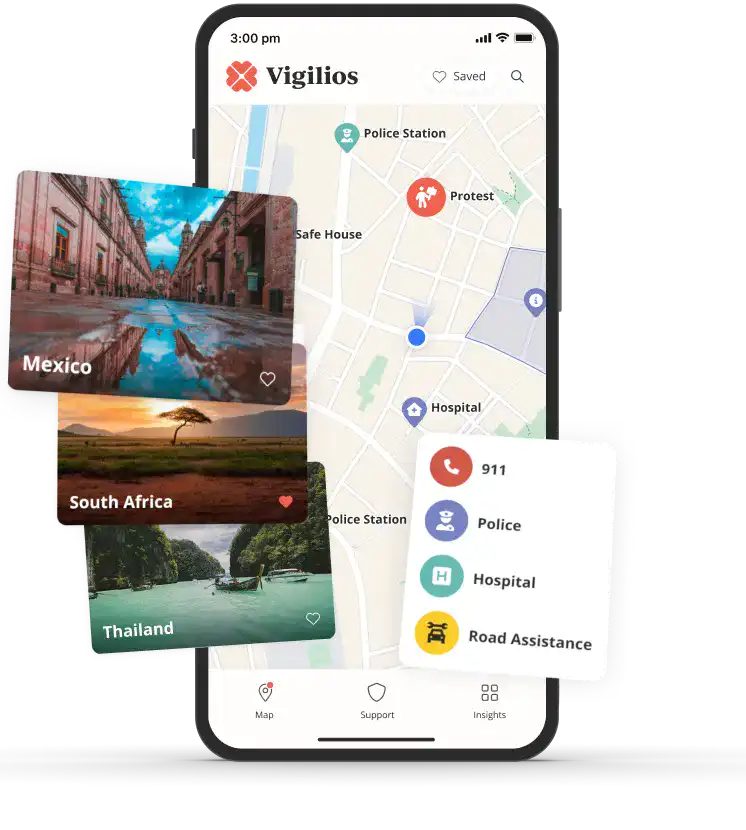Navigating Hurricane Season in Mexico: Essential Safety Advice

Table Of Contents
Mexico’s hurricane season runs from May to November with peak activity between July and October.
In the event of a hurricane alert in Mexico, prioritize securing accommodations and personal safety, particularly in flood-prone areas. Establish communication with hotel staff or locals for real-time updates on the storm. Adherence to evacuation orders is critical for safety.
The impact of hurricanes in Mexico varies regionally. The Atlantic basin sees activity peaking around September 10th, while the Pacific coast peak is less pronounced around late August. El Niño years can increase Pacific hurricane frequency and impact western Mexico more significantly.
The local Mexican population employs a variety of strategies to handle hurricanes, including sturdy infrastructure, emergency supplies, evacuation plans, and community preparedness with drills and education, offering important lessons for visitors.
Are you planning a trip to Mexico and wondering about hurricane season? The hurricane season in Mexico runs from June to November, with the highest risks occurring between August and October. Understanding the seasons is crucial for travelers aiming to safely enjoy Mexico’s vibrant culture and breathtaking landscapes. Our guide will provide essential tips and safety advice for navigating the unpredictable hurricane season, ensuring that you’re well-prepared without sacrificing the excitement of your Mexican adventure.
Key Takeaways
Understanding Hurricane Season in Mexico

Hurricane activity in Mexico typically occurs from late spring to late autumn, officially spanning from June through November. Mexico’s unique geographic location, with coasts on both the Pacific and Atlantic oceans, makes it susceptible to tropical storms from both sides, influencing the nation’s hurricane patterns.
The Atlantic coast experiences a peak in hurricane activity around September 10th, with heightened activity from mid-August to mid-October, which is during the official hurricane season. The Pacific coast, on the other hand, has a less pronounced peak around late August, with the season’s activity spread from late June to early October.
Peak Months for Storms
The peak months for storm activity in Mexico are August, September, and October. These months see the highest concentration of named storms, hurricanes, and major hurricanes. The Atlantic basin’s first hurricane typically forms in early to mid-August, and the first major hurricane around late August or early September.
Interestingly, there has been an upturn in tropical storm and hurricane landfalls in recent years, particularly on the Atlantic side of Mexico. This increase in activity is also observed on the Pacific coast in the northern hemisphere. Despite these trends, it’s essential to remember that each hurricane season is unique, and patterns can change from year to year.
Regional Variations in Storm Impact
The impact of hurricanes in Mexico varies regionally. Both the Pacific and Atlantic coasts are affected by hurricanes, with high vulnerability from July to October. The northwest of Mexico, including Sinaloa and the southern half of Baja California Peninsula, along with regions like Michoacán and the Yucatán Peninsula, are frequently hit.
Environmental factors, such as El Niño years, can increase the number of Pacific hurricanes, impacting weather patterns primarily on Mexico’s western coast. Historical hurricane events, such as Hurricane Gilbert in 1988 and Hurricane Wilma in 2005, have significantly impacted regions like Cancun on the Caribbean coast, which is adjacent to the Caribbean Sea.
Oaxaca and Mexico City: These inland destinations have less direct impact from hurricanes. Their best times are generally between October and May, avoiding the rainy season.
Puerto Vallarta (Pacific Coast): The best time to visit is from November to May, after the rainy season and avoiding the hottest, most humid months.
When to Visit: Timing Your Mexican Getaway

To best avoid hurricane season in Mexico and enjoy pleasant weather, aim to visit between late November and early May. This period offers milder temperatures and lower humidity, especially in popular coastal destinations like Cancun and Riviera Maya, and Cozumel.
It's also an ideal time for exploring cultural hubs such as Mexico City and Oaxaca, where the weather is conducive to outdoor activities and sightseeing.
While late September through October might see declining hurricane activity, it's wise to plan your visit for after this period to ensure a safer and more comfortable experience.
Best Times for Specific Regions
See also our Blog Post on the Top 10 Safest Cities in Mexico.
Preparing for Your Trip During Hurricane Season
Now, let’s discuss how to gear up for your trip during the hurricane season. Preparation is key to ensuring a hassle-free vacation, even when the weather is unpredictable. This includes safety measures, staying informed about storm activity, and having flexible travel plans.
A fundamental part of this preparation is securing comprehensive travel insurance that specifically covers hurricane damage, including trip cancellations and emergency evacuations. Additionally, it’s a good practice to keep important personal documents, such as passports and insurance cards, in a water-resistant container to prevent damage during a hurricane.
Safety measures and Preparations

While planning your trip, ensure you acquaint yourself with the safety measures and preparations recommended by local authorities and your accommodation in case of a hurricane. This includes knowing evacuation routes, emergency shelters, and how to stay informed about weather updates.
Additionally, keeping a list of emergency contacts, including local emergency services, the nearest embassy or consulate, and contacts at your accommodation, can provide additional security in the event of a hurricane. Knowing who to call in an emergency can make a significant difference to your safety and peace of mind.
Staying Informed: Tracking Storm Activity

Staying informed is key when dealing with hurricane season. Continuous monitoring of weather updates is paramount in your area to stay informed about a hurricane’s progress and potential impact. You can track coastal areas under hurricane warnings or watches using the National Hurricane Center’s (NHC) graphic representations.
Modern advances in technology have empowered meteorologists to more accurately predict and track storms, providing comfort to people who may be affected by severe weather. This improved forecasting can help communities better prepare for potential dangers. This improved accuracy can provide you with precious time to prepare and react if a hurricane threatens your vacation spot.
Flexible Travel Plans
Flexibility is another crucial element when preparing for the hurricane season. It can be beneficial to have adaptable travel plans during this unpredictable season. Consider booking accommodations and transportation that allow for last-minute changes without significant penalties.
This flexibility can help you navigate any unexpected weather changes with minimal stress.
Installing High-Velocity Hurricane Zone (HVHZ) storm shutters
Checking roofs for loose tiles
Improving drainage systems to mitigate water damage during hurricanes
Stock up on essential items such as a first aid kit, medications, extra clothes, nonperishable foods, bottled water, and cash.
Secure outdoor property to reduce the risk from flying objects.
Make preparations for potential power outages.
The Local Perspective: How the Mexican Population Handles Hurricanes

Let’s acknowledge the resilience of the Mexican locals. Living in a hurricane-prone area, they have developed effective strategies to handle hurricanes. This includes stockpiling a week’s worth of water and non-perishable food items, securing personal items from water damage, and taking safety measures seriously.
Access to information is also critical. Mexicans prepare by securing battery-operated radios and alternative lighting such as LED flashlights or lanterns with extra batteries, to stay informed about evacuations and other emergency announcements.
Building Resilience: Infrastructure and Evacuation Plans
Infrastructure in areas vulnerable to hurricanes is built to resist storm impacts. Some measures taken to protect homes from intense wind and debris include:
An effective evacuation plan is another critical component of hurricane resilience. This involves identifying safe locations and ensuring that all family members are aware of evacuation procedures.
Community Preparedness: Drills and Education
Preparedness at the community level plays a significant role in reducing the effects of hurricanes. Residents are advised to:
Public education on hurricane preparedness is conducted in Mexico, teaching businesses and workers about hazards and the necessary steps to handle hurricane events, like planning, equipping, training, and conducting drills. It’s clear that community drills and education play a vital role in preparing for hurricane season.
What To Do in Case of a Hurricane Alert

Having covered the basics of preparation and local resilience, let’s consider the steps to take if a hurricane alert is issued during your stay in Mexico.
First and foremost, secure your accommodations and personal safety. If you're in areas prone to flooding, seek higher ground or a designated safe location. Hotels in Cancun and Riviera Maya are often well-prepared for such events, with protocols in place to protect their guests.
Communicate with hotel staff or locals for the latest articles and updates on the storm's path and safety measures. Locals and regional authorities are invaluable resources for understanding the specific risks and appropriate precautions in their area. Follow evacuation orders if given, as these are issued based on the storm’s severity and its potential to hit the region with devastating winds and rains.
Remember, tropical storms can lead to severe flooding, making travel impossible for several days. The average temperatures and rain patterns you might expect during the summer or winter months can drastically change, affecting your vacation experience.
Stay indoors during heavy rainfall and avoid beach areas where wind speeds increase the risk of being hit by flying debris. Lastly, keep an emergency kit with essential supplies and documents, as storms can disrupt local services and supplies for several days, emphasizing the importance of being prepared in every season, not just during the peak of hurricane activity in summer and April.
After the Storm: Safety and Travel Considerations
After a tropical storm or hurricane has passed through the Mexican Caribbean, including popular vacation spots like Cancun and Riviera Maya, it's crucial to navigate the aftermath safely. Despite the end of the storm, the region, affected by heavy rains and high winds, may still pose risks. The hurricane season in Mexico, marked by the likelihood of such storms making landfall in the Gulf region, can disrupt travel plans year-round. Post-storm, the NOAA (National Oceanic and Atmospheric Administration) remains a reliable source for updates on residual weather patterns and warnings. Areas hit by the storm could experience flooding, damaged infrastructure, and altered temperatures, making it essential to stay informed and cautious.
Travelers should assess the impact on their vacation; this includes verifying the status of accommodations and local amenities in Cancun, Riviera Maya, and the wider affected region. Check for any travel advisories or restrictions in place and confirm flight availability. Remember, the aftermath of a tropical storm or hurricane can change the landscape, with some areas taking several days to return to normalcy. Prioritize safety over itinerary, and be flexible with travel plans. Communicate with local authorities and your home country's embassy if assistance is needed. The average conditions post-storm can significantly differ, so adjust expectations and plans accordingly, keeping in mind the region’s recovery efforts and the resilience of its locals and services.
Exploring indoor attractions that showcase the country’s rich cultural offerings
Visiting museums with pre-Hispanic artifacts in Mexico City
Taking a cooking class to learn how to make traditional Mexican dishes
Attending a live performance of traditional Mexican music or dance
Exploring the vibrant art scene in cities like Oaxaca and San Miguel de Allende
Enjoying Mexico Despite the Rain: Rainy Season Activities

Cooking Class as a Joyful Rainy Season Activity
Even with the challenges of the rainy season, Mexico boasts a variety of indoor activities and cultural experiences for you to enjoy. Here are some options:
There’s no shortage of rainy-day activities in Mexico, even during heavy rainfall.
For art enthusiasts, Mexico’s museums offer vast collections of artwork from different continents and centuries. Architecture buffs can visit landmark buildings with golden cupolas and Art Deco details for a dry and enlightening indoor experience during the rainy season. So, rain or shine, Mexico will keep you entertained!
Summary
To wrap things up, being prepared for hurricane season in Mexico involves understanding the season, staying informed about storm activity, taking necessary precautions, and having a flexible mindset. Ensuring you have comprehensive travel insurance and familiarizing yourself with the local measures in place to handle hurricanes can significantly enhance your safety. With these tips at your disposal, we hope you’ll have a safe and enjoyable trip to Mexico, come rain or shine!
Resources and Emergency Contacts
To complete your preparation, here are some valuable resources and emergency contacts:
These sources and contacts will provide you with important weather updates and assistance in case of an emergency in affected areas adding an extra layer of preparedness and peace of mind for your trip.
Frequently Asked Questions

What month has the most hurricanes in Mexico?
The most hurricanes in Mexico typically occur between July and October, with September and October being the most active months. September sees the highest number of hurricane landfalls on both oceanic coasts of the country.
What is the best month to go to Mexico?
The best month to go to Mexico is during the dry season, from December to April. November and March are also good options due to smaller crowds and lovely weather.
What months are bad weather in Mexico?
The bad weather months in Mexico are from May to September, with the highest risk of hurricanes between September and October. Be prepared for short spurts of rain in the mid-afternoon during the rainy season, followed by sunny stretches.
What part of Mexico is safest from hurricanes?
Puerto Vallarta, located on Mexico's Pacific coastline, is one of the safest places in Mexico from hurricanes due to its natural protection from the bay and surrounding mountains.





